In the intricate world of modern materials science, two terms frequently emerge: plastic and polyethylene. While often used interchangeably, it’s essential to understand their precise relationship. To answer directly: yes, polyethylene is plastic. Specifically, polyethylene is a type of plastic – a specialized yet interconnected subset of synthetic material technology. This article aims to demystify their relationship, exploring the nuanced characteristics that define each material and their critical roles in contemporary manufacturing and design, clarifying why the terms “plastic and polythene” are often used, and directly addressing questions like “is polyethylene a plastic?” and “is polyethene a plastic?” We’ll also delve into “what kind of plastic is polyethylene” and the broader “polyethylene vs plastic” discussion.
Defining Plastic: A Versatile Material Landscape
Plastic represents a broad, overarching category of synthetic or semi-synthetic materials characterized by their remarkable ability to be molded and formed into diverse shapes through the application of heat and pressure. Derived from polymers that can originate from natural sources (like cellulose) or, more commonly, from petroleum-based sources, plastics exhibit an extraordinary range of properties that make them indispensable across multiple industries. The term “plastic” is thus a general classification, encompassing a vast family of polymeric materials. This is the fundamental difference between polymer and plastic: a polymer is the large molecule, and plastic is the usable material made from polymers.
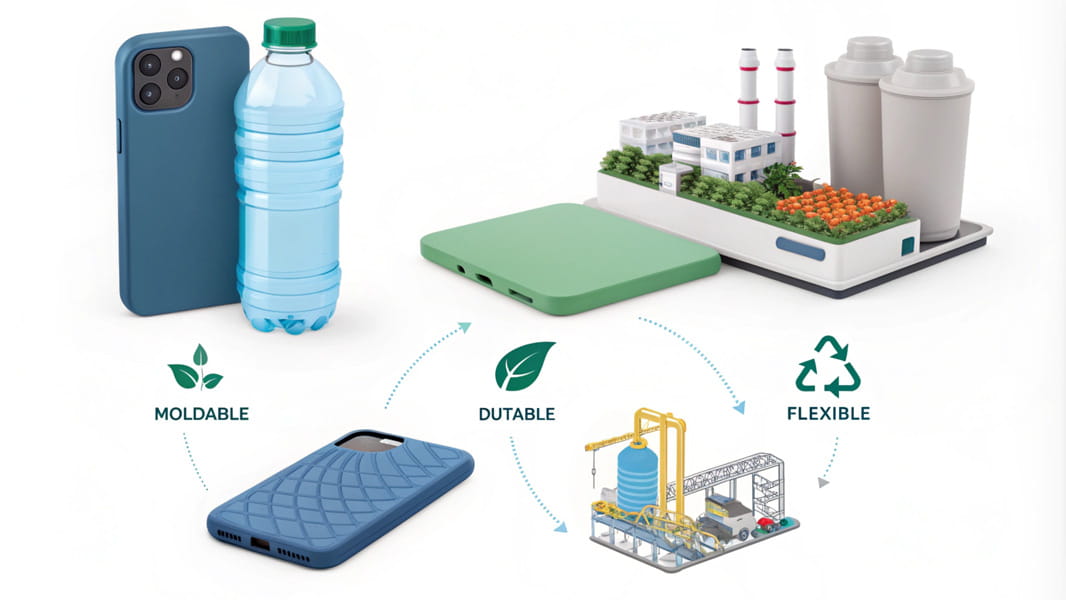
Core Characteristics of Plastics
The immense versatility of plastics is evident in their diverse attributes, which can be engineered for myriad applications:
- Exceptional Malleability and Shape-Adaptability: The defining characteristic of plastics is their capacity to be easily processed and formed into virtually any shape – from intricate components to large sheets and films.
- Variable Strength Configurations: Plastics can range from extremely rigid and strong (e.g., in engineering applications) to highly flexible and elastic (e.g., in films or elastomers). This variability defines the broad scope of “plastic vs. polyethylene” properties.
- Diverse Thermal Resistance: Different plastics offer varying degrees of resistance to heat, with some capable of withstanding high temperatures and others suited for low-temperature flexibility.
- Diverse Transparency and Aesthetic Possibilities: Plastics can be transparent, translucent, or opaque, and can be easily colored, offering vast aesthetic possibilities for design.
- Chemical Inertness: Many plastics exhibit good resistance to chemicals, making them suitable for containers and protective barriers.
- Lightweight: Generally, plastics offer a good strength-to-weight ratio, contributing to energy efficiency in transport and use.
Prominent Plastic Variants
The plastic family includes a multitude of distinct polymers, each with its own unique chemical structure and properties. Understanding these variants highlights the vastness of the “plastic” category beyond just polyethylene plastic:
Valued for its durability, stiffness, chemical resistance, and excellent fatigue resistance, often seen in consumer goods, automotive parts, and living hinges.
Renowned for its structural rigidity, weather resistance, and versatility in both rigid (pipes, window frames) and flexible (electrical insulation, flooring) forms.
A lightweight material prevalent in packaging solutions (e.g., foam cups, food containers), known for its rigidity and transparency.
Polyethylene Terephthalate (PET)
A transparent plastic used extensively in beverage containers (bottles for water, soda), and also for fibers (polyester).
Known for its exceptional impact resistance and optical clarity, used in CDs/DVDs, safety glasses, and durable glazing. This variety underscores that while they are all plastic, their individual characteristics make them suitable for vastly different purposes.
Polyethylene: A Specialized Plastic Subset
Polyethylene (PE) is not merely related to plastic; it is a specific, specialized type of plastic polymer. It is the most widely produced plastic globally, derived exclusively from the polymerization of ethylene monomers. The question “Is polyethylene a plastic?” can be definitively answered with a resounding yes. Similarly, “is polyethene a plastic?” also confirms its identity, as “polythene” is a common alternative name for polyethylene, especially in regions like the UK when referring to films and bags. Therefore, the terms “plastic and polythene” often refer to the broad category and this specific, highly popular type. This answers “what type of plastic is polyethylene” and “what kind of plastic is polyethylene” directly.
Distinctive Polyethylene Attributes
Within the broad plastic landscape, polyethylene is celebrated for a particular set of advantageous properties driven by its chemical structure:
- Superior Chemical Resistance: Polyethylene offers excellent resistance to acids, bases, and many solvents, making it ideal for storage containers and chemical processing.
- Remarkable Flexibility and Durability: Depending on its density (LDPE, HDPE, LLDPE), polyethylene can range from extremely pliable (e.g., plastic bags) to rigid and robust (e.g., pipes), while maintaining high impact strength. This variability within what are polyethylene plastics highlights its versatility.
- Consistent Transparency: While HDPE is opaque, LDPE and LLDPE offer varying degrees of transparency, making them suitable for clear films and packaging where product visibility is desired.
- Adaptable Manufacturing Potential: Polyethylene is highly versatile in processing methods, including extrusion, injection molding, and blow molding, allowing for a vast range of polyethylene products.
- Excellent Electrical Insulator: Its non-conductive nature makes it widely used in wire and cable insulation.
- Good Moisture Barrier: Effective at preventing water vapor transmission.
Polyethylene Classifications
Polyethylene itself is not a single material but a family of polymers, primarily differentiated by their density and molecular structure (degree of branching). This demonstrates that even within the specific answer to “is poly plastic,” there’s a spectrum of materials:
- Low-Density Polyethylene (LDPE): Known for its softness, high flexibility, and excellent clarity. LDPE is perfect for creating plastic bags, shrink wraps, squeeze bottles, and flexible containers. It’s ideally suited for uses that demand minimal structural rigidity and high pliability.
- Linear Low-Density Polyethylene (LLDPE): LLDPE boasts improved tensile strength, puncture resistance, and tear strength compared to traditional LDPE, thanks to its more linear molecular structure produced with specific catalysts. It’s commonly used in stretch films, agricultural films, and various high-performance packaging materials, offering better overall mechanical performance than LDPE.
- High-Density Polyethylene (HDPE): Notable for its superior structural integrity, rigidity, and strength-to-weight ratio. HDPE is utilized in rigid applications like pipes (water, gas), containers (milk jugs, detergent bottles), and durable toys. It provides an excellent balance of stiffness, impact resistance, and chemical resistance.
Each of these polyethylene types has distinct properties, demonstrating the diversity even within this specialized subset of plastic.
Contextualizing the Relationship: Plastic and Polyethylene
To truly comprehend the intricate relationship between these materials, consider the following analytical framework which clarifies the “plastic vs. polyethylene” dynamic and the “difference between polythene and plastic”:
| Comparative Aspect | Plastic | Polyethylene |
|---|---|---|
| Conceptual Definition |
Expansive material category of synthetic polymers. |
A specialized plastic subset; a specific type of polymer. |
| Molecular Composition |
Diverse polymer sources and chemical compositions. |
Exclusively ethylene-derived polymer. |
| Structural Flexibility |
Widely variable across different plastic types. |
Consistently predictable (e.g., LDPE is flexible, HDPE is rigid). |
| Primary Applications |
Multidisciplinary, from construction to electronics. |
Primarily packaging, films, containers, and piping. |
| Scope |
The general term. |
A specific example within that general term |
Conceptual Perspective: Is Polyethylene a Plastic? An Analogy
An illuminating analogy emerges for the plastic vs. polyethylene relationship: plastic functions as a comprehensive material family, with polyethylene representing a specific, well-defined member. Similar to how all squares are rectangles, but not all rectangles are squares, polyethylene is invariably plastic, yet not all plastics constitute polyethylene. When asking “is polyethene a plastic?”, the answer is unequivocally yes; it’s simply a common alternative name for this particular plastic. The terms “plastic and polythene” therefore refer to the broader category and one of its most prominent members, respectively. This reinforces “what type of plastic is polyethylene.”
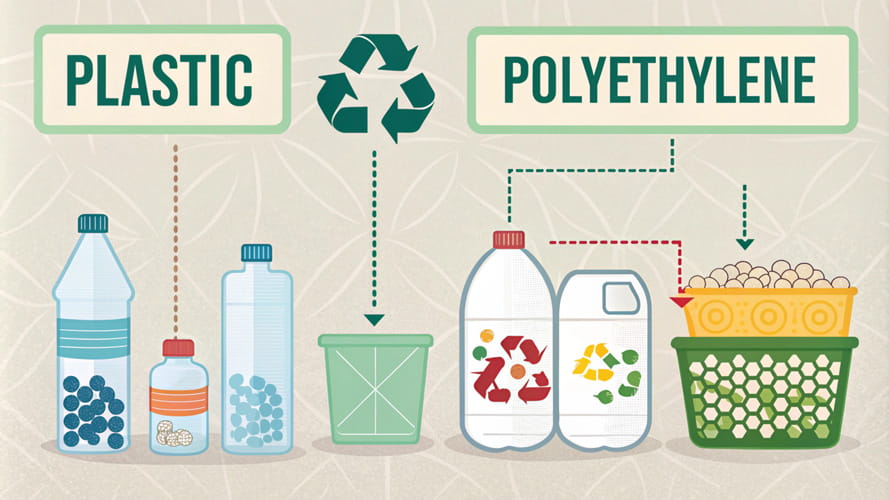
Practical and Strategic Implications
The distinctions between plastic and polyethylene transcend mere technical specifications, bearing significant consequences for various industries:
- Advanced Material Selection: Engineers and designers must choose the right type of plastic (e.g., polyethylene or polypropylene, PVC, PET) based on specific performance requirements. Understanding that polyethylene is a type of plastic helps narrow down options efficiently.
- Precision Engineering: Knowing the specific properties of polyethylene (HDPE vs. LDPE for example) allows for precise engineering solutions, optimizing products for durability, flexibility, and cost.
- Sustainable Design Strategies: For environmental purposes, the differences in recyclability, biodegradability (or lack thereof), and carbon footprint among various plastics (including polyethylene) are crucial for developing eco-friendlier products.
- Innovative Waste Management Approaches: Differentiating between polyethylene and other plastics is fundamental for effective sorting, recycling, and developing new waste management technologies. This is especially true when considering the difference between plastic and polythene in recycling streams.
Conclusion
The nuanced understanding of plastic and polyethylene’s relationship is paramount for professionals across diverse disciplines—from materials engineering to environmental science. It is essential to recognize that while every polyethylene is a plastic, not every plastic is polyethylene. This clarifies the “polyethylene vs. plastic” discussion.
As technological innovation and sustainability imperatives continue to evolve, these materials will undoubtedly play a crucial role in shaping our material landscape. Our challenge lies not just in understanding these materials, but in leveraging their unique properties to develop more sustainable, efficient solutions that address the complex demands of modern industry and environmental stewardship. The distinction between a general “plastic” and the specific “polyethylene” allows for precision in thought, design, and environmental action, ensuring that we continue to innovate responsibly with plastic and polythene alike.
Frequently Asked Questions: Plastic vs Polyethylene
- What is the primary difference between plastic and polyethylene?
Plastic is a broad category of synthetic materials that can be molded, while polyethylene is a specific type of plastic polymer derived exclusively from ethylene monomers. Think of plastic as a comprehensive family, with polyethylene being one well-defined family member. So, if you ask, “is polyethylene a plastic?”, the answer is always yes. This highlights the difference between plastic and polythene at a fundamental level. - Are all plastics the same?
No, plastics vary significantly in their composition, properties, and applications. Different types include Polypropylene (PP), Polyvinyl Chloride (PVC), Polystyrene (PS), and Polyethylene Terephthalate (PET), along with various types of polyethylene (HDPE, LDPE, LLDPE). Each has unique characteristics suited to specific uses, making the “plastic vs. polyethylene” distinction important. This also explains why “is poly plastic” isn’t a simple yes/no without context. - Is polythene the same as polyethylene?
Yes, “polythene” is simply an alternative, and often regional, name for polyethylene. So, if you’re asking “is polyethene a plastic?”, the answer is the same: yes. The terms “plastic and polythene” are often used to refer to the general category and this specific type, respectively. This clarifies the difference between polythene and plastic. - What type of plastic is polyethylene?
Polyethylene is a thermoplastic polymer. It falls under the broader category of polyolefins. Within polyethylene itself, there are several distinct types such as HDPE, LDPE, LLDPE, and UHMWPE, each with varying densities and branching structures that give them unique properties and uses. This fully answers “what type of plastic is polyethylene” and “what kind of plastic is polyethylene.”

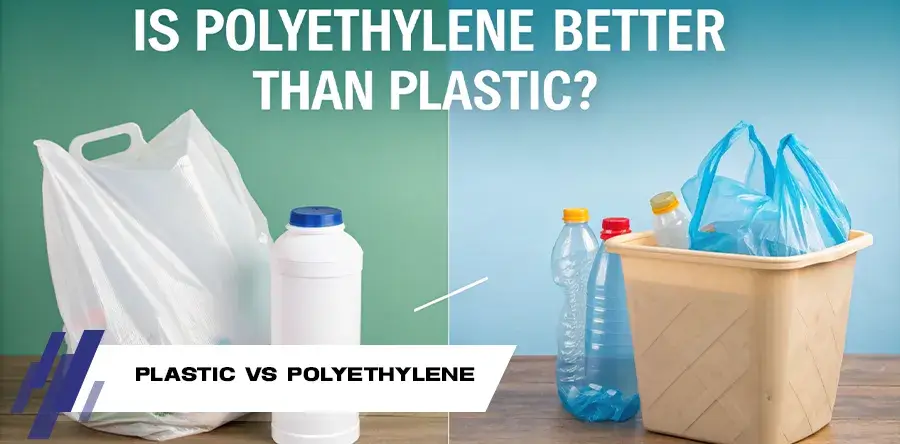

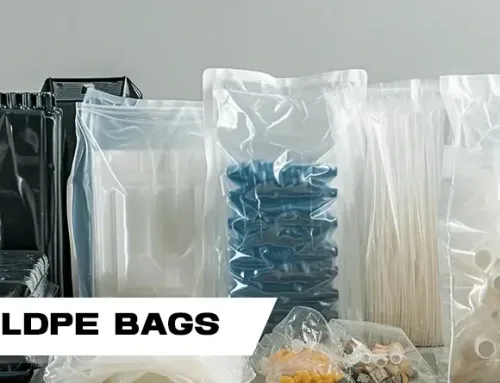
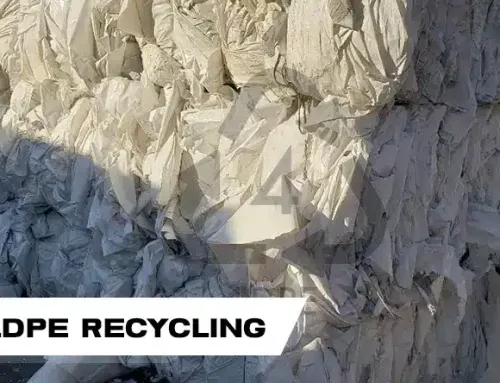
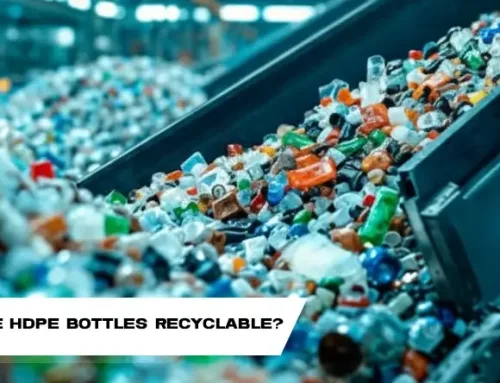
Leave A Comment